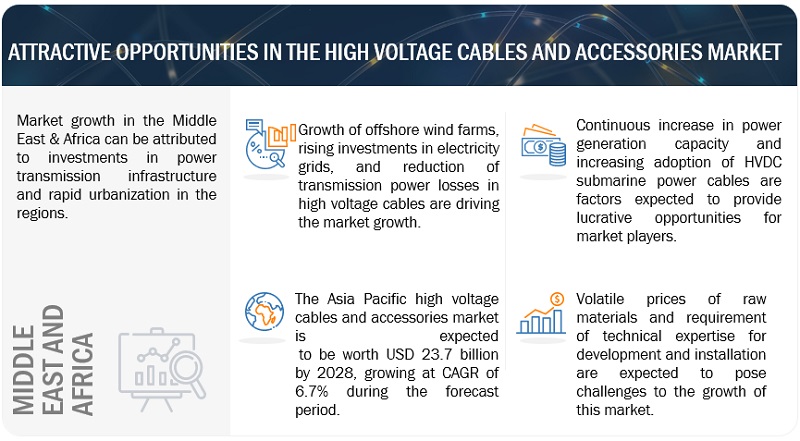The global high voltage cables and accessories market is projected to reach USD 52.5 billion by 2028 from an estimated USD 40.0 billion in 2023, at a CAGR of 5.6% during the forecast period. High voltage cables and accessories are primarily used in power transmission and distribution systems. They enable the efficient transmission of electricity at high voltage levels from power plants to substations and between different substations. These cables and accessories are essential for the reliable and safe operation of electrical networks, ensuring the delivery of electricity to end users.
Key Market Players
The major players in the high voltage cables and accessories market are Prysmian Group (Italy), Sumitomo Electric Industries Ltd. (Japan), Nexans (France), LS Cable & System Ltd. (South Korea), and NKT A/S (Denmark).
Download PDF Brochure @ https://www.marketsandmarkets.com/pdfdownloadNew.asp?id=95892251
Some key trends in such as the growing power generation capapcity, and increasing shift towards renewables drive the market for high voltage cables and accessories with the rising need for effective power transmission. This has enhanced the high voltage cables and accessories market.

This report segments the high voltage cables and accessories market based on conductor type into two types: copper and aluminum. The aluminum segment is expected to be the second-largest segment in high voltage cables and accessories market in the forecast period. Aluminum has high electrical conductivity, low resistance, and excellent thermal conductivity. It is lightweight and availability everywhere. All these features establish aluminum as a preferred material for electrical conductors across diverse industries. Aluminum conductors are frequently used in overhead power lines, facilitating the transmission and distribution of electricity. Their lightweight characteristics and cost-effectiveness make them suitable for long-distance transmission, where cable weight plays a crucial role. These conductors exhibit excellent resistance to corrosion and possess the capacity to handle high-voltage power, making them well-suited for power transmission. They find their applications in electrical power distribution, building wiring, industrial applications, transportation, renewable energy projects, substations and transformers.
This report segments the high voltage cables and accessories market based on installation into three segments: overhead, underground, and submarine. Submarine installation is expected to be the fastest growing segment in the market. Submarine installation is vital infrastructure laid on the seabed to facilitate power transmission across vast bodies of water, connecting remote offshore renewable energy sources, such as offshore wind farms or tidal power installations, to onshore grids. This promotes the utilization of clean and renewable energy, supporting global efforts towards reducing carbon emissions and combating climate change. Submarine installation utilizes specialized cables that are made to endure the challenging underwater environment, including extreme pressures, temperature variations, and corrosive conditions. Submarine cables provide a reliable and secure means of interconnecting power grids between countries or regions. The increasing demand for electricity, particularly in coastal areas and island nations, necessitates the expansion of power transmission infrastructure underwater, enhancing the segmental landscape.
Request Sample Pages @ https://www.marketsandmarkets.com/requestsampleNew.asp?id=95892251
The world has experienced a significant rise in power generation capacities over the years, driven by increasing energy demand, economic growth, and efforts to improve access to electricity. As a result, the demand for transmission equipment has also been steadily increasing, leading to adoption of high voltage cables and accessories. The cable industry has witnessed significant technological advancements that have simplified the design, installation, and maintenance processes of cables. With the backing of stakeholders, the implementation of these advanced technologies can proceed smoothly, enabling the expansion of power generation capacities and the efficient transmission of electricity.


